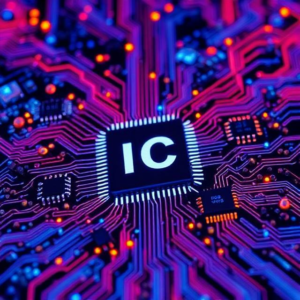What is TTL Logic?
TTL Logic is a type of digital logic circuit that uses transistors to perform logic operations (like AND, OR, NOT). It’s called Transistor-Transistor Logic because it uses two transistors in each logic gate.
TTL was one of the earliest forms of digital logic used in computers, calculators, and many other electronic systems. It became popular because it was fast, reliable, and easy to manufacture.

How Does TTL Logic Work?
TTL circuits use transistors to build logic gates. Let’s look at the basic components and how they work together.
- Basic Components:
- Transistor: A transistor is a device that can act as a switch. It either lets current flow (on) or stops current (off). In TTL logic, BJT (Bipolar Junction Transistors) are used.
- Resistor: Used to control the flow of current in the circuit.
- Power Supply: TTL logic usually operates with a 5V power supply, where a voltage of 5V represents a logic “1” (high) and 0V represents a logic “0” (low).
- How Transistors Work in TTL:
- In a TTL logic gate, two transistors are used to control the flow of current.
- A voltage input is applied to the base of the first transistor, and depending on whether the base voltage is high or low, the transistor will either allow current to pass through (turn on) or not pass current (turn off).
- This is how the logic functions are implemented — the combination of transistor states (on/off) results in logic operations (like AND, OR, NOT).
Types of TTL Gates
TTL logic circuits can perform basic logic functions (AND, OR, NOT). Each function is made with a combination of transistors and resistors. Here are the main types of TTL gates:
- NOT Gate (Inverter):
- A NOT gate inverts the input. If the input is 1, the output will be 0, and if the input is 0, the output will be 1.
- In TTL, this is done using a transistor that either conducts (allows current) or doesn’t, depending on the input.
- AND Gate:
- An AND gate gives an output of 1 only when both inputs are 1.
- In TTL, an AND gate is built by connecting transistors in such a way that current only flows when both inputs are high (1).
- OR Gate:
- An OR gate gives an output of 1 when at least one input is 1.
- In TTL, an OR gate is built by connecting transistors that allow current to flow if either input is high (1).
- NAND, NOR, XOR Gates:
- These are variations of the basic AND, OR, and NOT gates. They perform the same basic operations but with slight variations, such as NAND being the opposite of AND, and NOR being the opposite of OR.
Advantages of TTL Logic:
- Speed: TTL circuits were faster than earlier logic families like DTL (Diode-Transistor Logic), making them good for high-speed applications.
- Reliability: TTL logic circuits are very reliable and can handle noise well, making them ideal for industrial applications.
- Ease of Use: TTL logic gates are easy to design and manufacture. They became the standard in many early digital systems, including early computers.
- Widely Available: TTL chips (like 7400-series ICs) are widely available and were used for many years in digital circuits.
Disadvantages of TTL Logic:
- Power Consumption: TTL logic tends to consume more power compared to modern logic families like CMOS (Complementary Metal-Oxide-Semiconductor).
- Heat: Because of the higher power consumption, TTL circuits can generate more heat compared to CMOS, which can be a limitation in some applications.
- Size: Early TTL chips were relatively large compared to modern technologies, though this has improved over time.
How TTL Logic is Used
TTL logic gates are the building blocks for creating more complex digital circuits. Some common uses include:
- Computers and Microcontrollers:
- In older computers and early microcontrollers, TTL logic gates were used to perform all the basic logic operations needed for processing information.
- Many early digital systems used TTL logic ICs to build systems like adders, counters, and memory.
- Timing Circuits:
- TTL logic is often used to create timing circuits, where the behavior of a system depends on specific time intervals or events.
- Control Systems:
- TTL logic can be used in control systems, like those used in industrial machines, where it helps in controlling processes by making decisions based on inputs (e.g., turn on/off motors, set alarms).
- Counters and Registers:
- TTL logic can be used to build counters and registers, which store and count digital data in systems like clocks or data processors.
Summary:
- TTL Logic uses transistors to build logic gates like AND, OR, NOT, and more. It is a key part of digital circuits and electronics.
- Transistors act as switches, allowing or blocking current to perform logical operations based on input voltages.
- TTL logic is fast, reliable, and easy to use, but it consumes more power compared to newer technologies like CMOS.
- Applications of TTL logic include computers, control systems, timing circuits, and digital processors.











